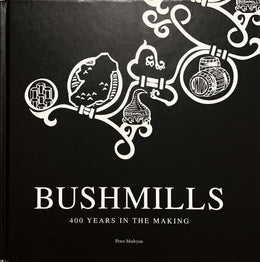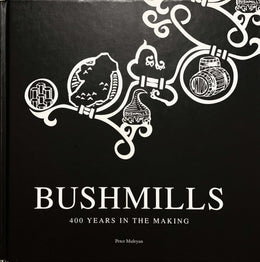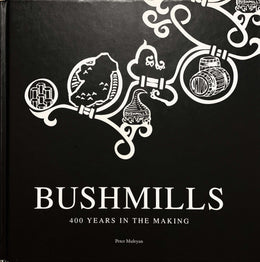The Nugent family have had a long association with the whiskey business in Northern Ireland. James Nugent was Managing Director of McConnell's, a Belfast firm of brewers and whiskey bonders. While running the family brewery, his son Chester Nugent started making barley on contract for Guinness of Dublin in the 1920s. After their own brewery went into liquidation, Chester struck up a relationship with Old Bushmills.
As early as 1932 we know from James Morrison's journal that Old Bushmills was supplying the Dublin brewer:
"...throughout the season I can recall nothing of any real interest to write about, except that on completing our own malting we became Maltsters making on contract through a Belfast businessman, Chester Nugent, malt for Guinness in Dublin."
This early connection between Bushmills and Guinness, two of Ireland's most famous brands, has not been given the attention it deserves. Here were two major drinks companies, who found themselves on different sides of a border, cordially doing business throughout the 1930s and 1940s, at a time when relations between north and south were strained. The Irish Free State dropped the oath of allegiance to the British Crown, declared itself a Republic and remained neutral during the Second World War.
This north-south relationship continued when Chester Nugent and his son Granville opened a new malt house, just outside Belfast. A letter dated 25th April 1941 from the Ards Malting Company to Guinness in Dublin, outlines the problems Nugent was having getting an export licence to send malt south of the border during the war. Chester Nugent writes of the Blitz and "the terrible hammering that we got here last Tuesday week, our Maltings just escaping". Whether or not he knew about the units of the Dublin fire brigade that had crossed the border to help their counterparts in Belfast is not known. Either way he was only able to promise 1,000 barrels of the 8,500 ordered.
Corns of barley. Barley is an essential ingredient in the creation of both whiskey and beer.

It was clear that supplying Dublin with malt from this own facility was going to be an ongoing problem, but he had a plan. Nugent would try to get the Boyds to handle the brewers' barley.
"I am endeavouring to arrange to malt this at Killowen or Bushmills Mailings, but I do not know whether I will be able to accomplish it or not. These Mailings are at present filled up with Whiskies removed from Belfast by order of the Ministry of Public Security since the last 'blitz'."
The Luftwaffe raid on Belfast had been deadly. Vast parts of the city had been levelled: the Boyds had lost their Hill Street headquarters. Not only were valuable papers gone, but a bonded warehouse full of precious and rare mature whiskey went up in smoke. The resulting fire raged so fiercely that steel beams buckled and the building smouldered for a week. After this all remaining whiskey was moved out of Belfast.
It is clear that Guinness badly needed malt supplies from Northern Ireland:
"We would emphasise that we really require as much as possible, and are willing to pay for it."
It is also clear Nugent was doing his best to supply them: fit the moment we are. negotiating for the Mailings at Bushmills Distillety, in the hope that we may be able to malt there next season."
Both sides kept in constant contact during this difficult period, and from the letters that crossed between Belfast to Dublin, we can get a really good picture of what was happening in all three of the Boyd distilleries during the war.

The aftermath of a raid during the Belfast Blitz. Through the smoke and dust we can see the forlorn figure of the Albert Clock in the background.
In July, Nugent wrote:
"Killotven, although not altered very much, is still occupied by the Militaiy...Bushmills is a rather different proposition, as the bottom floor of the Malt House is now a Bond Store and full of Whiskey to the utmost at the moment. Windows have all been built up and a wall built across it to conform to British Customs regulations which you know are very verystrict...There is another old Malting at Comber Distillery which I will inspect shortly, but I hardly think it is suitable."
The inspection Nugent speaks ofwas published in August 1941 and his Report on Malting Accommodation in Northern Ireland catches the industry at the very point of death. Five of the six Maltings Nugent visited had been attached to breweries or distilleries, and a generation earlier they had been working to full capacity. What Nugent found made very sobering reading.
The Old McConnell's Brewery had, he wrote "been altered so much that they could not be used for Malting purposes or drying grain." The silent Dunville's Distillery was found to be "full of wood stored there on behalf of the Northern Ireland Government...The kiln attached to this building is dismantled." Then there was what remained of Northern Ireland's recent distilling industry. Old Comber was found to be "completely unsuitable. . .there is no machinery of any description". Killowen was "occupied by the Military, housing 100 soldiers. The two barley lofts are used as sleeping quarters...the malting floor has been divided across from wall to wall by two brick divisions, one part used as a cook-house, the other as a canteen". Even if these walls were ripped out, Killowen's potential capacity was tiny, estimated at 50 tons per week.
Then there was Old Bushmills, which "could be used for Malting purposes if the Whiskey now stored in the ground working floor was removed and the brick wall 43 ft long, across the house also removed".
By September Guinness were still waiting to hear if they would get malt from Bushmills. Chester wrote to Wilson Boyd on the 16th of the month asking:
"When do you think you would be in a position to come to any definite decision?"
Wilson Boyd was playing a waiting game. He was trying to get a licence to distil and if successful, there wouldn't be enough time in the season to both supply Guinness and distil whiskey. It was another two years before Guinness got the good news they had been waiting for. On 23rd August 1943 Chester Nugent confirmed in a letter to the brewer:
"I have been able to get the use of the Bushmills Malt House and provided no unforeseen circumstance would arise, such as occupation by the Military or interference by the British Customs and Excise, I think I would be able to do it."
By the end of the Second World War, a tradition that had started some twenty years earlier recommenced, as Old Bushmills started malting again for Guinness of Dublin. But it was not to continue; the days of the distillery producing its own malt were numbered. The future lay in the sixth and final malt house, of which Nugent wrote —his own Ards Malt Company. This was a state-of-the-art complex "in first class repair. Being a new Maltings, it is up-to-date in every way and capable of drying 140 tons of grain per week."
If the Bushmills makings couldn't cut it, it was also clear that there was no future for Killowen. There is however one final story about Killowen. During the war it was used to store the casks of maturing Bushmills that had been taken out of Belfast. It was also used as a base for US soldiers. It is not surprising that Jimmy Morrison's suspicions were aroused when, despite having the necessary paperwork, he was refused access to the Killowen site. He returned with the local police chief to find American troops had been helping themselves to the maturing whiskey The 'free bar' was closed and within 48 hours all the American troops had been moved somewhere less exciting.
By the end of the Second World War the price of whiskey had increased from 10 shillings a proof gallon to more than 200 shillings. By 1945 the maturing whiskey stocks that had been laid down since the mid-1930s were now approaching their tenth birthday. The Boyd family, who had invested heavily in whiskey since the early 1930s, were sitting on liquid gold. They were also facing a windfall tax, with no easy get-out clause like after the First World War. That loophole had been closed in 1938. With the growth of global branding, the days of the family-run distillery were numbered.
Written by Peter Mulryan
The text is an excerpt from "Bushmills: 400 Years in the Making" (pp. 96 - 101), written by Peter Mulryan, published 2008 by Appletree Press Ltd.







